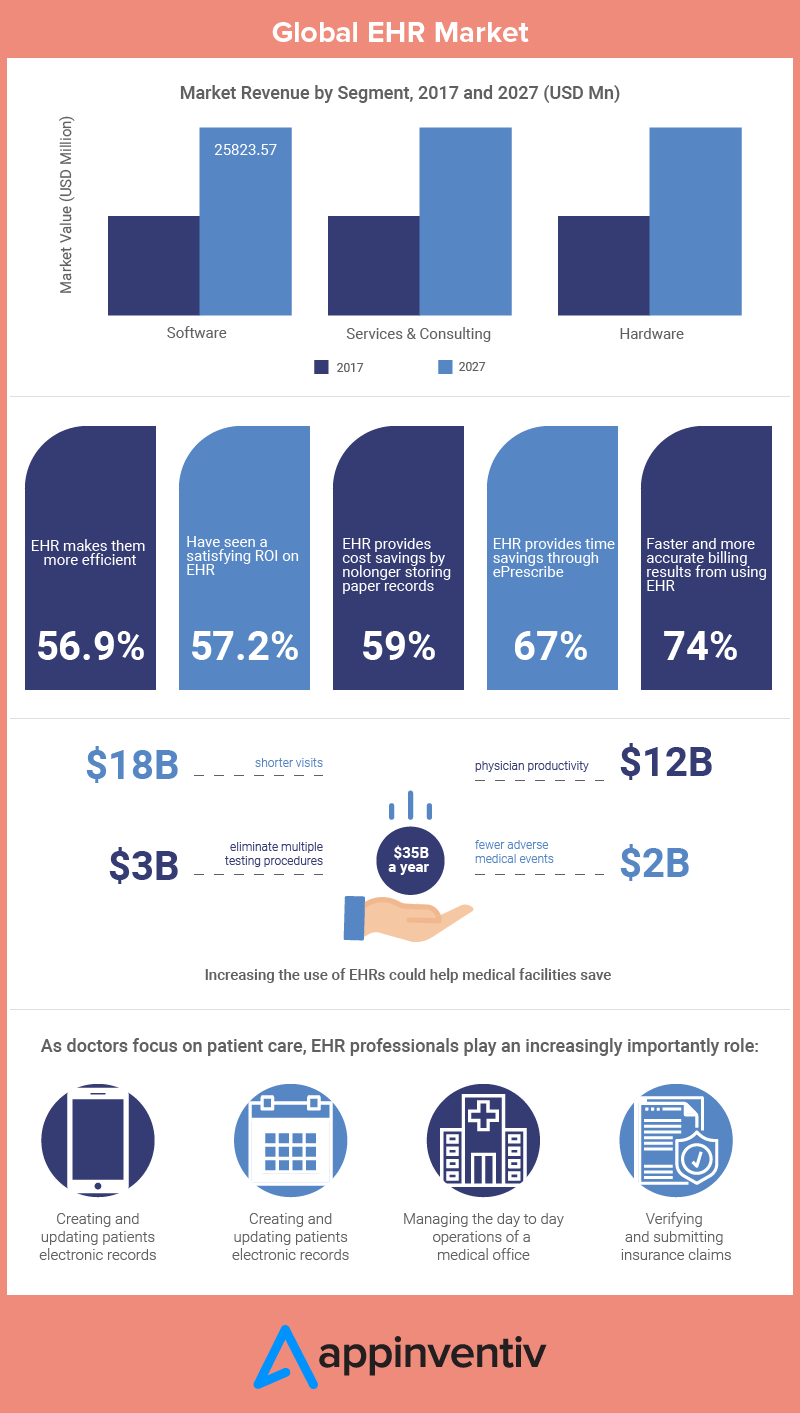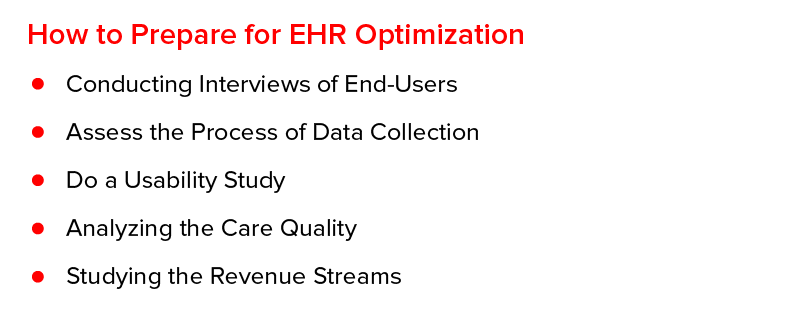EHR Optimization Guide to Make Your Healthcare Offering Efficient
Now that you have gone about the whole implementation and making EHR live process after several days of planning, configuration, testing, and training, the hard part should probably be over, no? Especially now when your EHR is working as it was expected to be? Well, no. With EHR optimization left to be attended, the work is far from over.
The stage at which EHR is made operational in a health and care ecosystem, unlike what commonly assumed to be the last stage is only the beginning. There is a whole set of process waiting to be held once the system is implemented in the structure.
The set of process that goes on to live till much after the Electronic Medical records are launched is known as EHR Optimization – the process that was one of the biggest healthcare trends of 2018 and will continue to be in the time to come. The whole process of optimization is undertaken to ensure that the solution continues to offer what it was originally ideated for, efficiently and smoothly.
Let us look a little into the present EHR market – the one that has marked the evolution of healthcare from 1.0 to 3.0 – before we get to the part which shows what an efficient EHR looks like and the phases that define the complete optimization process. A market that has made questions like what does EHR stand for or what is an EHR system obsolete.

Seeing the growth trend that the EHR market is on, it is easy to presume that you too are either planning to incorporate the system in your ecosystem or you already have one. In both cases, before you move on the part where you look into its optimization, it would be a lot more important to look into what exactly constitutes a good EHR system.
Without an understanding of what is EHR Optimization or what an efficient EHR system is made of, you will not be able to start the whole process of optimization, something which is aimed at making the process better and more productive over time.
So, let us look at what makes up for a good EHR solution – something that we have observed in great depth by being the leading healthcare app development company.
What Does a Good EHR Solution Entail?
According to the uniformed criteria set by the healthcare industry, here are the three different factors that help gauge the effectiveness of an Electronic Health Record System:
Have clear claims data for identifying when tests were performed?
No EHR system can be truly effective until it accepts and analyzes all the claims data. The system should provide the medical stakeholders with data of when the patient received treatment or care or vaccine while informing them of any care gaps – something which lowers the risks that the patients face of not getting the care which they need and at a time when they need.
A Scope of High Customization
The possibility of an EHR for being customized according to the specific requirement of the stakeholder is important for using the system for improving patient care. If customer wise customization seems like a lot of work, your system should at least have enough customization for your different medical practice.
Integration and Connection
The EHR should be developed in a way that its integration is possible in the revenue cycle management and practice workflow management. Also, it should be structured in a way that messaging and e-prescribing functionality is added, for they both are equally beneficial for increasing the quality and speed of the care given along with bettering the patients’ outcomes.
So here were the factors that are known to be the measure of EHR effectiveness in the healthcare industry. And now that you know what they are, you have a starting point to analyze if at all you need to optimize EHR this very instant.
Well whether you want it now or not, workflow analysis and EHR implementation is not something that you can delay forever. There will come a time when your solution will have to go through the different phases of optimization.
Preparing you for the time to come, here are the three stages which your EHR Optimization process will go through.

Before we look into how EHR Optimization Activities for Improving Clinical Efficiency are undertaken, it is important to get an understanding of the phases in which optimization happens.
Here are the three phases optimization goes through, which help define the benefits of electronic health records.
- Stabilization: This is the stage where the providers are able to go back to pre-go-live productivity levels. All the medium and high priority issues coming in from the go-live stage are resolved. Majority of the EHR users should show a basic level of system’s competency.
- Proficiency: The issues which were identified in the implementation process will be addressed. The practices will be adopted and will be maintained with the intended workflows. All the stakeholders would now be showing an operational and functional level of efficiency.
- Improvement: The support and training process is now designed on the basis of specific performance-related goals, which would be driven by metrics. Performance improvement will be made an ongoing process.
A key element in optimizing EHR is knowing when is the time to prepare for optimization.
Now that we have looked at the different phases which gives an idea into how EHR optimization process would move, let us look into the ways you can prepare for the optimization of your EHR system.

Knowing when it is time to optimize the EHR solution is not an easy task. There are a number of things you have to keep into consideration in order to be better prepared for optimizing the EHR system for both – better clinical decision and operational effectiveness.
Here are the ways you can analyze your current EHR Optimization Strategies to check if it is in need of optimization –
1. Conducting Interviews of End-Users
You should start by reviewing the everyday operations of the end-users. Ask the employees what parts need to be improved and what is going great for them. And on the basis of this, assess the utilization of the end users’ system.
2. Assess the Process of Data Collection
The process through which data is collected carries an impact on everything between direct decision making of patient care to triggering the best practices alerts. Ensuring that correct data is being collected in the right form is very crucial and equally crucial is to ensure that the complete workflow looks at the provider’s view of the aggregation data.
3. Do a Usability Study
It is important to review how the clinicians interact with EHR, which even includes how they work around the clinical and hardware tools. While doing usability testing, it is also very important to see the documentation points where the data is to be changed either from free form to discreet or from discreet to free form. At this point, you should also analyze if there is a scope of including technologies like Blockchain to revolutionize your Healthcare offering.
4. Analyzing the Care Quality
List down all the clinical variation inside the organization. Identify and dissect the cost and supply trends across the complete high-volume and high-cost situations and then identify the right care standards for those conditions and see if the EHR system is supporting the transition to the standards.
5. Studying the Revenue Streams
See if your EHR system is able to do an in-depth root cause analysis of the claims denials and backlog and then lower it. Your EHR should be able to automate the whole authorization process through healthcare workflow optimization. In case there is some gaps or lags in the process, you would know that it is time for optimization.
With this, you have now seen what defines a good EHR solution, the different steps of EHR optimization, and ways you can prepare for the optimization.
Now that we have looked into the preparation part of how to improve EHR, in the next and last segment of the article today we will look into how to optimize your existing EHR system effectively in order for it to offer the biggest value.
EHR Optimization Best Practices

Lower the Overload of Information
The usual intent of EHR developers and the medical stakeholders and one of the major points of EHR improvements is to give physicians complete clinical and health data at the point of care. But, we often forget that too much data can hinder the caregivers’ efficiency for they would now spend most of their time in sifting through the large pool.
So, it is very important that you back at the redesign of the physicians’ note template. What our team of EHR developers suggests is using an accordion display in the notes section to only show the very important part of the patient data and hiding the rest until a further click is made.
Specialize in the Clinical Workflow
At Appinventiv, we are always willing to partner with the healthcare organizations in order to specialize the clinical workflows for meeting the specific needs of individual care settings, health systems, hospitals, and care settings.
In our experience, we have seen that specializing the workflow to display information that is frequently used by the providers of specific specialities help the users in navigating the EHRs more easily.
Creation of individual workflow enables the providers to access the relevant information in patient EHRs.
Add Health IT Tools in the Mix
Integration of IT-based health tools in the EHR system can help better the clinic process and care delivery, like the impact of Google Cloud Healthcare API on the system. But when you make the EHR too techy, the learnability scale can deviate the physicians from their main job. So, it is very important to prioritize the usability before you add in a new tool in the solution.
What we recommend is adding any IT functionality in the mobile platform that is present with the medical practitioners, so that they can use the techy technology when on hospital room or home visit.
Also, when integrating an IT tool with the EHR solution, you will have to ensure that they require very fewer log-ins and are accessible to the providers on the move so that its usability and care coordination is maintained.
Work With a Reliable EHR Provider
The next step in optimizing your present EHR solution or the beginning of its planning is to work with a trustworthy EHR provider who understands the different details of the whole process and know the tricks of the trade to make it all a lot more efficient.
Without the support of an EHR provider, chances are that you will miss out on the portions that need modifications and parts that need not be touched for the present time. They will help you get a better idea of what has to be done to make the whole system experience more value embedding.
With this, you now know everything there is to know about optimizing your present EHR system. In case you need more detailed insight into the topic, get in touch with our team of EHR service providers, today!


strategies your digital product..



